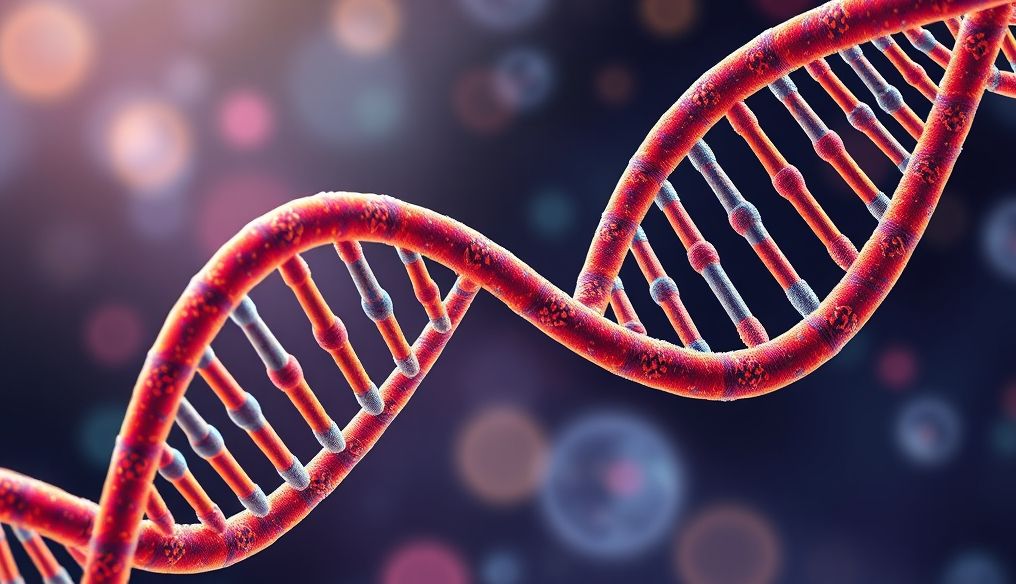What is DNA?
DNA, or deoxyribonucleic acid, is a complex molecule that carries the genetic instructions necessary for the growth, development, functioning, and reproduction of all known living organisms and many viruses. It can be likened to a detailed, encoded instruction manual containing all the information a living organism needs to become what it is.
Structure of DNA
DNA is composed of subunits called nucleotides. Each nucleotide consists of three main parts:
- Deoxyribose sugar: A five-carbon sugar.
- Phosphate group: Attached to the deoxyribose sugar.
- Nitrogenous base: There are four types of nitrogenous bases in DNA:
- Adenine (A)
- Thymine (T)
- Guanine (G)
- Cytosine (C)
DNA consists of two long strands of nucleotides that twist around each other to form a double helix structure. The nitrogenous bases in the two strands are connected to each other according to specific rules: Adenine (A) always pairs with Thymine (T), and Guanine (G) always pairs with Cytosine (C). This specific pairing ensures that the two strands are complementary.
Function of DNA
The main function of DNA is to store and transmit genetic information. This information is essential for:
- Determining genetic traits: Such as eye color, hair color, and height.
- Directing protein synthesis: Proteins are the molecular machines that perform most of the cell's functions.
- Replication: Before a cell divides, DNA must be replicated to ensure that each new cell receives a complete copy of the genetic information.
How Does DNA Determine Our Genetic Traits?
Imagine DNA as a huge book containing different chapters, each chapter representing a gene. A gene is a segment of DNA that carries the instructions needed to make a specific protein. Proteins are responsible for most of the cell's functions and determining genetic traits.
Genes and Proteins
Genes consist of a specific sequence of nucleotides. This sequence determines the order of amino acids in the protein. The order of amino acids determines the protein's shape and function. For example, a specific gene may carry the instructions needed to make a protein responsible for producing melanin pigment, which determines the color of skin, hair, and eyes.
Heredity and Genetic Traits
We inherit half of our DNA from our mother and the other half from our father. This means that we inherit two copies of each gene, one copy from each parent. These two copies may be identical or different. If the two copies are different, one may be dominant and the other recessive. The dominant gene is the one that shows its effect on the genetic trait, while the recessive gene only shows its effect if it is present in two copies.
Example: If you inherit a dominant gene for brown eyes and a recessive gene for blue eyes, your eyes will be brown. But if you inherit two recessive genes for blue eyes, your eyes will be blue.
Environmental Influences
It is important to note that genetic traits are not only determined by DNA. Environmental factors also play an important role. For example, height is affected by heredity, but it is also affected by nutrition and health conditions in childhood.
Protein Synthesis: From DNA to Protein
How is the information in DNA converted into proteins? This complex process involves two main steps:
Transcription
In this step, a segment of DNA (a gene) is copied into a molecule called messenger RNA (mRNA). mRNA acts as a carrier of genetic information from the nucleus to the ribosomes, which are the cellular factories that make proteins.
Translation
In this step, the ribosome reads the sequence of nucleotides in mRNA and uses it to assemble amino acids in the correct order to form the protein. Each three nucleotides (codon) in mRNA specifies a particular amino acid.
Genetic Mutations and Their Impact
Mutations are changes in the DNA sequence. Mutations can occur spontaneously or due to environmental factors such as radiation or chemicals. Mutations can be harmful, beneficial, or have no effect at all.
Types of Mutations
- Point mutations: A change in a single nucleotide.
- Frameshift mutations: The addition or deletion of one or more nucleotides.
- Chromosome mutations: Changes in the structure or number of chromosomes.
Impact of Mutations
Mutations can lead to a variety of effects, including:
- Genetic diseases: Such as cystic fibrosis and Huntington's disease.
- Cancer: Mutations in genes that control cell growth can lead to cancer.
- Evolution: Mutations are the source of genetic variation that allows organisms to adapt to changing environments.
Modern Applications of Understanding DNA
Our growing understanding of DNA has led to the development of many important technologies and applications, including:
Genetic Diagnosis
Genetic tests can be used to identify people at risk of developing certain genetic diseases, or to diagnose genetic diseases early.
Gene Therapy
Gene therapy is a promising technique that aims to treat genetic diseases by introducing healthy genes into the patient's cells.
Genomics
Genomics is the study of the entire genome of an organism. Genomics can be used to understand how genes work and interact with each other, and to develop new treatments for diseases.
Gene Editing (CRISPR)
CRISPR technology is a powerful tool that allows scientists to edit genes precisely. CRISPR can be used to treat genetic diseases, to improve agricultural crops, and to develop new treatments for diseases.
The Future of DNA Research
DNA research continues to evolve at a rapid pace. In the future, we can expect to see more progress in areas such as:
- Personalized medicine: Developing customized treatments for individuals based on their unique genetic makeup.
- Disease prevention: Identifying people at risk of developing certain diseases and taking preventive measures to reduce that risk.
- Extending lifespan: Understanding the biological processes that lead to aging and developing strategies to slow them down.
"DNA is the foundation of life, and our understanding of it will continue to change the way we think about health and disease." - National Human Genome Research Institute




